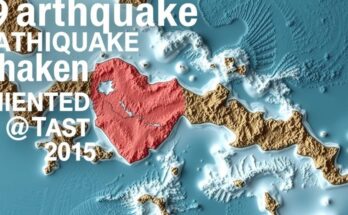The entire island of Cuba faced a power outage following Hurricane Rafael, a Category 3 storm that caused severe destruction to agricultural areas. Residents are frustrated by the government’s response amid ongoing economic struggles and previous power outages. As the hurricane season progresses, concerns grow regarding future storms and Cuba’s vulnerable infrastructure.
After the passage of Hurricane Rafael, the entire island of Cuba has experienced a widespread power outage for the second time in two weeks. The hurricane, classified as a Category 3 storm, left substantial destruction in its wake, particularly affecting the agricultural regions in Artemisa and Pinar del Rio, where essential crops were damaged. The storm struck with maximum sustained winds of 185 km/h (115 mph), causing significant disruptions and raising concerns over life-threatening storm surges and flash floods, given Cuba’s vulnerable infrastructure. In Havana, residents reported dry streets in the aftermath, yet the city was eerily quiet with businesses and schools closed, as transportation services slowly resumed operations. Authorities temporarily suspended flights at major airports like Havana’s Jose Marti International Airport and the Varadero beach resort. Despite the military being mobilized to assist, many citizens voiced their frustrations and anxiety regarding their government’s response to these repeated crises, particularly due to previous issues stemming from outdated energy infrastructure. As of now, the situation remains precarious with uncertainty lingering over the restoration of power and emergency services. Cubans are grappling with not only the physical damage but also the emotional toll of repeated natural disasters and lack of governmental support. The ongoing hurricane season, which has been particularly active this year, raises further alarms for the island’s future. Adding to the desperation were accounts from residents who suffered personal losses and faced dire circumstances without power. This follows a recent similar blackout, blaming aging thermoelectric power stations, further compounding the issues at hand. With the volume of storms predicted to increase next season, authorities and citizens alike must prepare for more potential challenges ahead.
Cuba is particularly susceptible to severe weather due to its geographical location and aging infrastructure. Past hurricanes have already exposed critical weaknesses in the country’s power grid and public services. The economic crisis, compounded by strained relations with the United States and challenges faced by its key allies, has hindered the government’s ability to respond effectively to natural disasters. Its vulnerable agricultural sector, reliant on specific climatic conditions, is at constant risk during hurricane seasons, which has been notably active this year with a forecast for increased storms in the future. Hurricane Rafael marks the 17th named storm this season and the 11th hurricane to occur this year, emphasizing the severity of the ongoing hurricane season affecting the region. Historical patterns show a growing intensity in storm activity, leading to concerns for the 2024 hurricane season forecast.
In summary, the devastation wrought by Hurricane Rafael has underscored Cuba’s ongoing struggles with natural disasters and infrastructure challenges. With the entire island in blackout due to the storm, and residents facing immense pressure from repeated crises, the outlook appears bleak. This situation has prompted citizens to call for more effective government support and sustainable infrastructure solutions. Looking forward, as storm activity is likely to escalate, the Cuban government must prioritize enhancements to their disaster preparedness and response capabilities.
Original Source: www.aljazeera.com




